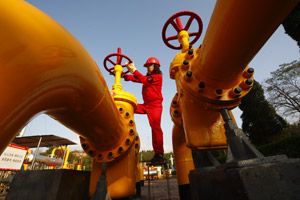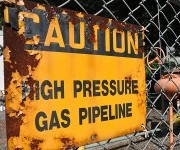Photo: Kara NewhouseCross-posted from Climate Progress.
A group of experts brought together by the Department of Energy (DOE) is calling for more research into the life-cycle greenhouse-gas emissions from hydraulic fracturing, a drilling technique that has caused explosive growth in the natural gas industry.
Hydraulic fracturing, or fracking, pumps water, sand, and chemicals underneath shale formations to force out trapped gas. It allows companies to access massive reserves of gas that were formerly unreachable. But drilling operations also leak large amounts of methane, a potent greenhouse gas, which calls into question claims that natural gas is “clean.”
One recent peer-reviewed study suggested that natural gas is actually dirtier than coal when factoring in methane leakage at drilling operations. Other studies have found just the opposite. So which is it?
A panel convened by the DOE weighed in on the matter this morning. The seven-member panel released a report [PDF] of environmental guidelines for the natural gas industry, with one of the main recommendations being more study of the “cradle-to-grave” emissions profile of natural gas:
There have been relatively few analyses done of the question of the greenhouse-gas footprint over the entire fuel cycle of natural gas production, delivery and use, and little data are available that bear on the question. A recent peer-reviewed article reaches a pessimistic conclusion about the greenhouse gas footprint of shale gas production and use — a conclusion not widely accepted. DOE’s National Energy Technology Laboratory has given an alternative analysis. Work has also been done for electric power, where natural gas is anticipated increasingly to substitute for coal generation, reaching a more favorable conclusion that natural gas results in about one-half the equivalent carbon dioxide emissions.
These data will help answer key policy questions such as the time scale on which natural gas fuel switching strategies would produce real climate benefits through the full fuel cycle and the level of methane emission reductions that may be necessary to ensure such climate benefits are meaningful.
Methane emissions from shale gas drilling, production, gas processing, transmission, and storage are of particular concern because methane is a potent greenhouse gas: 25 to 72 times greater warming potential than carbon dioxide on 100-year and 20-year time scales respectively. Currently, there is great uncertainty about the scale of methane emissions.
In January, the DOE set up a committee to examine the full range of environmental impacts of fracking. Climate Progress editor Joe Romm testified to the members, urging them to study the climate issue closely:
I told the committee that peer-reviewed and other research on the total life-cycle emissions of greenhouse gases from unconventional natural gas had raised serious questions about whether it has significantly lower emissions than coal and oil in various applications. Until this issue is resolved, it is unclear whether the federal government should make major investments in promoting natural gas use, including natural gas vehicles. I am glad the committee called for analysis to settle this important issue.
The International Energy Agency (IEA) has called today’s boom in fracking the “Golden Age of Gas.” But IEA Executive Director Nobuo Tanaka admits that natural gas is “no panacea for climate change.” As Climate Progress reported in June, a report from the IEA on shale gas finds that rapid growth could result in global temperature rises of 6 degrees F.
Along with global greenhouse-gas emissions, there are major concerns about local environmental problems near drilling sites. Fracking releases smog-forming air toxics and creates huge amounts of wastewater filled with chemicals and high levels of radiation. In order to prevent air and water contamination problems, numerous states and municipalities in the U.S. have partially or fully halted fracking. And last month France became the first country to implement a nationwide ban.
The DOE panel also weighed in on these issues, urging the natural gas industry to disclose chemicals used in the water-sand mixture that pushes shale gas to the surface. Due to a 2005 exemption from the Clean Water Act aggressively supported by then-Vice President Dick Cheney, natural gas companies in most states do not have to reveal what type of chemicals are being pumped underground.
The DOE panel said the law needed to change:
[T]here is no economic or technical reason to prevent public disclosure of all chemicals in fracturing fluids, with an exception for genuinely proprietary information. While companies and regulators are moving in this direction, progress needs to be accelerated in light of public concern.
The panel also urged companies to stop pouring diesel underground, again explaining that there is “no technical or economic reason” for its use.
Other recommendations include better water recycling methods, increased air-quality standards to lower on-site emissions, and more R&D to develop “green” fracking mixtures.
As the debate about the true cleanliness of shale gas rages on, the DOE is trying to get out ahead of the issue. The next step will be to turn these guidelines into action — a task that will prove much more difficult than simply issuing recommendations.




